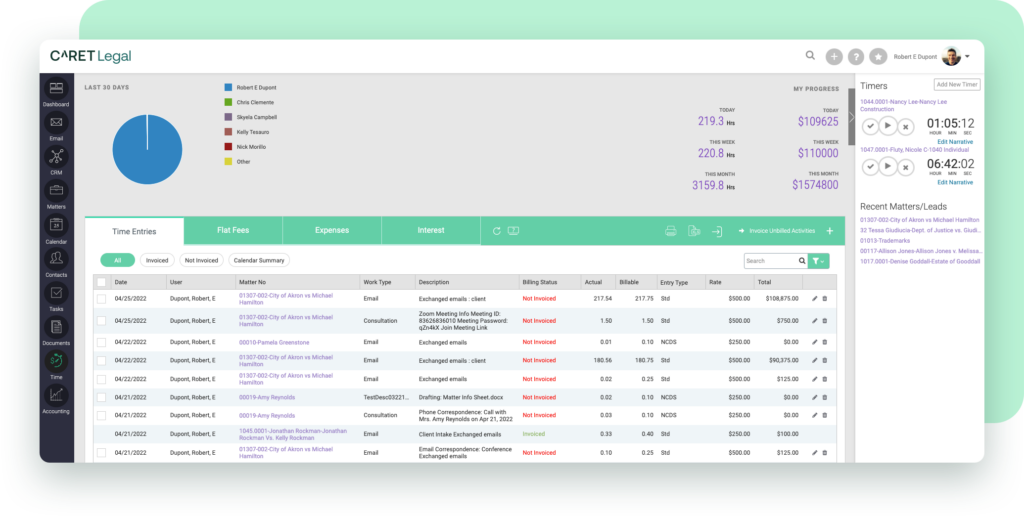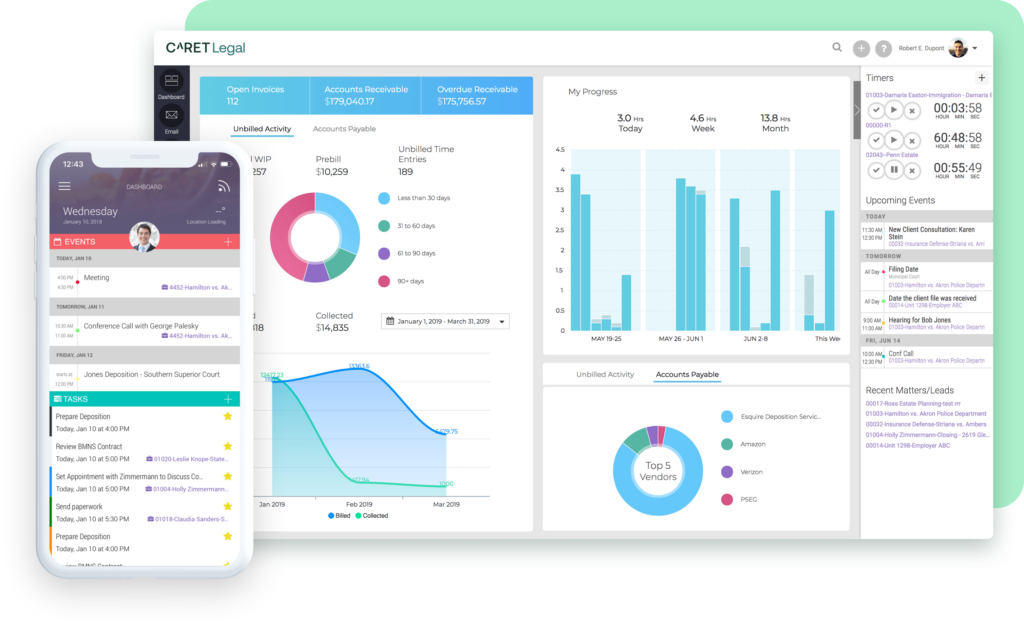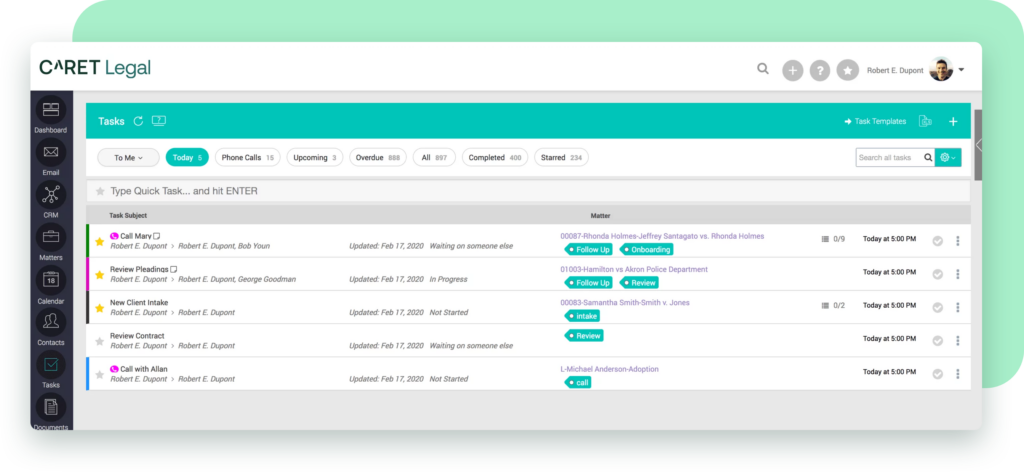When your legal team focuses on the right tasks at the right time, it leads to increased productivity, improved client outcomes, and ultimately, a more profitable firm.
Effective prioritization is the cornerstone of success. It’s not just about working hard; it’s about working smart. When your legal team focuses on the right tasks at the right time, it leads to increased productivity, improved client outcomes, and ultimately, a more profitable firm.
However, many law firms fall into common prioritization pitfalls that can derail even the most well-intentioned teams. These may include getting bogged down in endless email chains, allowing administrative tasks to overshadow critical case work, or failing to delegate effectively. The consequences of these missteps can be severe: missed deadlines, dissatisfied clients, and lost revenue opportunities.
Let’s begin by examining some of the most prevalent day-to-day prioritization mistakes that law firms often encounter.
Common Day-to-Day Prioritization Mistakes
There are common pitfalls that many law firms face when it comes to daily task prioritization. By recognizing these issues, you’ll be better equipped to avoid them and implement more effective strategies.
Email Overload
One of the most pervasive issues in law firms today is the overemphasis on email responsiveness at the expense of substantive work. While client communication is crucial, constantly monitoring and responding to emails can fragment attention and reduce productivity on more critical tasks. Attorneys may find themselves spending hours each day managing their inbox rather than focusing on case strategy or document preparation.

Too Much Admin Work
Another common pitfall is allowing routine administrative tasks to overshadow high-value client work. Tasks like timekeeping, filing, or organizing documents are necessary, but they shouldn’t consume the bulk of an attorney’s day. When these tasks take precedence over billable work or strategic case management, it can lead to inefficiencies and reduced profitability.
Mismanaged Time
Misallocation of senior attorney time is another frequent issue. Experienced lawyers often find themselves handling tasks that could easily be delegated to junior associates or paralegals. This not only reduces the firm’s overall efficiency but also limits opportunities for junior staff to develop their skills and take on more responsibility.
Delayed Growth
Lastly, many firms struggle with neglecting business development activities due to immediate case pressures. While it’s understandable to focus on current clients and active cases, failing to allocate time for networking, marketing, and cultivating new client relationships can lead to feast-or-famine cycles in workload and revenue.
To illustrate the importance of effective prioritization, let’s consider a real-world example. According to Hannah Stitt of Tectonic, LLP,
“Before using CARET Legal, seven hours elapsed from the time we initially saw a lead to a signed retainer. But once we used custom intake forms to populate CARET Legal as well as a task template, the firm reduced that time to 2.5 hours.”
This dramatic improvement in efficiency demonstrates the power of proper task prioritization and management.
Team Tips for Identifying High-Value Daily Tasks
Effective task prioritization begins with identifying which tasks truly matter. In a law firm, this involves balancing client needs, revenue generation, team development, and risk management. We’ll examine each of these areas in detail to help your team focus on what’s most important.
Client-Centric Prioritization
At the heart of any successful law practice is a focus on client needs. When prioritizing daily tasks, it’s crucial to put emphasis on activities that directly impact active case progression. This might involve drafting key documents, preparing for upcoming hearings, or conducting critical research. By focusing on tasks that move cases forward, you ensure that client matters are progressing efficiently and effectively.
However, client-centric prioritization isn’t just about ongoing casework. It also involves balancing urgent client requests with existing responsibilities. When a client calls with an immediate concern, it’s important to assess its urgency and potential impact on other ongoing work. Sometimes, these requests may need to take precedence, while other times, they can be scheduled for later attention without compromising client satisfaction.
Revenue-Driven Daily Focus
While serving clients is paramount, law firms are businesses that need to generate revenue to survive and thrive. This means identifying and prioritizing tasks with immediate billable potential should be a daily focus. This could involve working on substantive legal documents, conducting billable research, or engaging in billable client communications.
Equally important is ensuring that time-sensitive billing and invoicing tasks are completed promptly. Delayed invoicing can lead to cash flow issues and disputes over billable hours. Make it a priority to review and submit time entries daily, and set aside dedicated time for preparing and sending out invoices according to your firm’s billing cycle.

Daily Team Management and Development
Effective prioritization isn’t just about individual tasks; it’s also about team development. Prioritizing check-ins and feedback sessions with junior attorneys should be a regular part of senior attorneys’ daily schedules. These interactions don’t need to be lengthy – even brief, focused conversations can provide valuable guidance and support.
The challenge lies in balancing these mentorship activities with billable work. One approach is to integrate mentorship into billable activities where possible. For example, involving junior attorneys in case strategy discussions or document reviews can serve both mentorship and billable objectives simultaneously.
Routine Risk Management
Risk management is an ongoing necessity. Daily conflict checks and ethical compliance tasks should be non-negotiable priorities. These activities might not always feel urgent, but neglecting them can lead to severe consequences down the line.
Additionally, tasks related to imminent deadlines and court appearances should always take high priority. Missing a court deadline or being unprepared for a hearing can have serious repercussions for both the case and the firm’s reputation. Implement a system to flag these critical dates well in advance, ensuring that preparation begins early and is prioritized appropriately.
With a clear understanding of what tasks should take priority, the next challenge is implementing a system that ensures these priorities are consistently acted upon.
When prioritizing daily tasks, it’s crucial to put emphasis on activities that directly impact active case progression.
How to Implement a Better Prioritization System
Knowing what to prioritize is only half the battle. The other half is implementing systems that support and reinforce good prioritization habits across your entire team. Here are four key strategies to help your firm establish a robust prioritization system.
Hold Morning Strategy Sessions
One of the most effective ways to align team priorities is through brief daily huddles. These morning strategy sessions provide an opportunity for team members to share their top priorities for the day, discuss any potential roadblocks, and ensure that everyone is working towards common goals. These meetings don’t need to be lengthy – even a 15-minute stand-up can significantly improve team alignment and focus.
To make these sessions more effective, consider using digital boards for visual task management that can provide a clear, visual representation of tasks in various stages of completion. This allows team members to quickly understand the status of different projects and adjust their priorities accordingly.
Promote Use of Legal Practice Management Software
Legal practice management (LPM) software can be a game-changer when it comes to task prioritization and management. These platforms often come with robust task assignment and tracking features, allowing team leaders to allocate work effectively and monitor progress in real-time.
Moreover, many LPM solutions offer automated reminders and deadline management tools. These features can help ensure that critical tasks don’t fall through the cracks and that team members are alerted well in advance of upcoming deadlines.

The impact of such tools can be significant. Again, Hannah Stitt from Tectonic, LLP notes,
“With CARET Legal, we don’t need to copy ourselves on email messages, you can find the information you need from various custom views when you need it. You can quickly see the last communications with a client using a communication log and track all system activity from audit log files.”
This level of organization and accessibility can dramatically improve a team’s ability to prioritize effectively.
Recommend Time Blocking Techniques
Time blocking is a powerful technique for ensuring that high-priority tasks receive the focused attention they deserve. This method involves designating specific blocks of time for particular types of work. For instance, you might set aside two hours each morning for your most challenging or important tasks when your energy and focus are at their peak.
It’s also beneficial to designate specific times for email and administrative work. This helps prevent these necessary but often less critical tasks from interrupting more substantive work throughout the day. For example, you might check and respond to emails for 30 minutes at the start of the day, after lunch, and before ending your workday.
Employ Delegation Best Practices
Effective delegation is crucial for optimal task prioritization. This involves a daily assessment of task allocation across the team. Leaders should regularly evaluate which team members have capacity and which are overloaded, adjusting assignments as necessary to maintain balance and efficiency.
Utilizing paralegals and junior associates effectively is a key aspect of smart delegation. These team members can often handle routine research, document preparation, and administrative tasks, freeing up senior attorneys to focus on more complex legal work and client relationships.
Remember, delegation isn’t just about offloading work – it’s about matching tasks to the most appropriate skill sets and experience levels within your team. This not only improves overall efficiency but also contributes to the professional development of junior team members.
While a robust prioritization system is crucial, it’s equally important to prepare for the inevitable challenges that arise in day-to-day legal practice.

How to Address Daily Prioritization Challenges
Even with the best systems in place, legal teams will inevitably face challenges that can disrupt their carefully planned priorities. Next, we’ll discuss strategies for managing common obstacles to prioritization.
Managing Interruptions and Urgent Requests
Unexpected client demands and urgent requests are par for the course. The key is to have strategies in place for triaging these interruptions without derailing your entire day. One effective approach is to designate a team member as the first point of contact for urgent matters. This person can assess the urgency of requests and only escalate truly time-sensitive issues to the appropriate attorney.
For individual attorneys, it’s crucial to develop techniques for maintaining focus on high-priority tasks even in the face of interruptions. This might involve using the “two-minute rule” – if a task will take less than two minutes, do it immediately; if not, schedule it for later. Another useful technique is to keep a running list of interruptions and address them during designated times throughout the day, rather than allowing them to constantly disrupt your workflow.
Balancing Billable and Non-Billable Work
Striking the right balance between billable and non-billable work is a perennial challenge for law firms. Daily tracking of billable hours versus administrative time can provide valuable insights into where time is being spent and help identify areas for improvement. Many legal practice management systems offer features to easily track and categorize time spent on different types of tasks.
Integrating business development into daily routines is another important aspect of this balance. This might involve setting aside a specific time each day for networking, following up with potential clients, or working on marketing materials. By treating these activities as non-negotiable parts of the daily schedule, firms can ensure that long-term growth isn’t sacrificed for short-term billable work.
Adapting to Case Developments
Legal cases are dynamic, and new information or developments can suddenly shift priorities. Having techniques for rapidly reprioritizing when new case information emerges is crucial. This might involve a quick team huddle to reassess priorities, or using your legal practice management system to quickly reassign tasks and adjust deadlines.
Managing the ripple effects of priority shifts across the team is equally important. When one case suddenly demands more attention, it often means other work needs to be redistributed. Clear communication channels and flexible team members are key to navigating these shifts smoothly.
Once you’ve established strategies for managing daily challenges, the next step is to ensure your prioritization efforts are yielding the desired results.
Performance Tracking and Adjustment
Implementing prioritization strategies is an ongoing process that requires regular assessment and refinement. We’ll now cover methods for tracking your team’s performance and making necessary adjustments to ensure continuous improvement in task management.
End-of-Day Team Debriefs
Just as morning huddles set the tone for the day, end-of-day debriefs provide an opportunity for quick assessment of daily goal achievement. These brief sessions allow team members to share successes, discuss challenges, and align on priorities for the following day. They also provide a natural moment for identifying and addressing recurring productivity bottlenecks.
These debriefs don’t need to be lengthy – even a 10-minute check-in can yield valuable insights. The key is consistency and open communication. Encourage team members to be honest about what worked well and what didn’t, fostering a culture of continuous improvement.
Effective prioritization isn’t just about systems and strategies—it’s about creating an organizational culture that values and reinforces smart task management.
Utilizing Practice Management Analytics
Modern legal practice management systems offer a wealth of data that can inform your prioritization strategies. A daily review of key performance metrics can provide invaluable insights into team productivity, case progress, and financial performance. Look at metrics such as billable hours logged, tasks completed, deadlines met (or missed), and revenue generated.
Making data-driven adjustments to task allocation based on these analytics can significantly improve your team’s efficiency. For instance, if the data shows that certain types of tasks consistently take longer than expected, you might need to adjust your time estimates or consider additional training for team members handling these tasks.
Client Communication Efficiency
Balancing client communication with productive case work is a constant challenge for many legal professionals. Developing strategies for streamlining daily client updates can help maintain client satisfaction without overwhelming your team.
The goal is to find a balance between responsiveness and productivity. As noted in the CARET Legal case study, efficient systems can dramatically reduce the time spent on certain client-related tasks.
Effective prioritization isn’t just about systems and strategies—it’s about creating an organizational culture that values and reinforces smart task management.
Fostering a Culture of Smart Prioritization
Creating lasting change in how your firm prioritizes tasks requires more than just new systems and processes. It requires a shift in organizational culture. Let’s delve into strategies for embedding prioritization into the very fabric of your firm’s daily operations.
Leading by Example in Daily Practices
Creating a culture of effective prioritization starts at the top. Senior partners and firm leaders need to model the behaviors they want to see in their teams. This means being transparent about their own prioritization processes, demonstrating how they handle interruptions, and showing a commitment to continuous improvement in their own work habits.
Transparency in daily decision-making processes is key. When leaders explain the reasoning behind their prioritization choices, it helps team members understand the strategic thinking involved and apply similar principles to their own work.
Daily Recognition
Implementing quick daily shout-outs for team members who prioritize effectively can reinforce good habits and motivate others. This doesn’t have to be a formal process – it could be as simple as acknowledging someone’s smart decision-making during the morning huddle or end-of-day debrief.
Sharing daily success stories in team meetings is another powerful way to reinforce the importance of prioritization. These stories can illustrate the real-world impact of smart task management, whether it’s meeting a tight deadline, resolving a complex client issue, or simply having a more balanced and productive workday.
Continuous Micro-Learning
Incorporating brief daily tips on prioritization in team communications can help keep best practices top of mind. This could be as simple as sharing a “Tip of the Day” in your morning team email or during your daily huddle.
Encouraging the sharing of daily productivity hacks among team members can foster a collaborative learning environment. Everyone has their own tricks and techniques for managing their workload – by sharing these openly, the entire team can benefit from collective wisdom and experience.
By fostering a culture that values and rewards smart prioritization, you create an environment where effective task management becomes second nature. This not only improves day-to-day operations but also contributes to long-term firm success and employee satisfaction.
Redefine Your Firm’s Approach to Tasks
Effective daily prioritization is a critical factor in the success of any law firm. The strategies we’ve discussed – from morning huddles and legal practice management software to time blocking and smart delegation – form the foundation of an effective prioritization system. When implemented thoughtfully, these practices can transform your firm’s daily operations.
Remember, the goal of prioritization isn’t just to get more done – it’s to ensure your team is focusing on the right tasks at the right time. This leads to improved client outcomes, increased billable hours, and ultimately, a more successful and profitable firm.
Each day of focused, strategic work builds upon the last, leading to more efficient case management, stronger client relationships, and a more engaged team. Implementing prioritization strategies may require initial effort, but the long-term benefits are well worth it. By making smart prioritization a core part of your firm’s operations, you’re setting your team up for sustained success in an increasingly competitive legal landscape. Remember, the journey to better prioritization is ongoing. Continuously assess your processes, be open to feedback, and adjust your strategies as needed.
Ready to take the next step in optimizing your firm’s task management? Schedule a free demo of CARET Legal today and see how it can revolutionize your prioritization processes.
